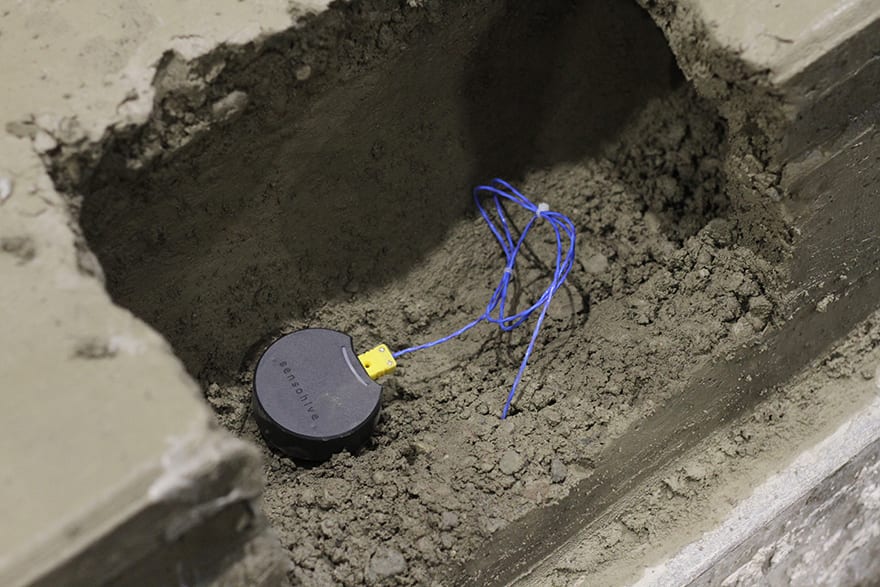More than 30 European contractors have deployed a Danish concrete strength monitoring system that harnesses the Internet of Things (IoT) and cloud technology to provide real-time data.
Projects run by Skanska, VolkerWessels, Swedish construction company NCC, and Norway’s Kruse Smith have rolled out the Maturix system, by Sensohive, which utilises thermal sensors, long range wireless transmitters and a custom cloud platform to provide contractors and engineers with insights into the curing process on a mobile device.
The system is designed to expedite construction schedules, improve safety, and replace the industry standard “cube test” that involves casting test specimens during concrete pouring.
Rasmus Uhre, product manager at Sensohive, told BIM+: “[Cube test] specimens are typically left onsite in the same conditions as the structure, but as seen in several trials, there is a substantial difference when it comes to strength development, which cannot be reflected or replicated in the specimens. Maturix monitors strength in real-time – at multiple positions in the structure – and measurements provide an exact insight, not a ‘well-calculated guess’.”

Maturix temperature data is collected by industry standard type K thermocouples embedded in concrete and sent using the wireless transmitters
The transmission of data over the long-range and low-power demand Sigfox 0G IoT network, offers benefits over systems that exploit Bluetooth near field communications (NFC) to transmit curing data to mobile devices via a wireless gateway.
NFC systems require the individual to be physically present on the jobsite and hold a phone close to the sensor to take readings.
Maturix temperature data is collected by industry standard type K thermocouples embedded in concrete and sent using the wireless transmitters to radio towers in the surrounding area. In locations with limited or no connectivity, data is sent to a local base station.
“The Sigfox network has very good range and penetration capabilities, making it ideal for use on construction sites and in precast plants,” says Uhre. “Our wireless transmitters can run for several months/years depending on use. If used all the time, they can last around eight months, and we usually swap-and-service them free of charge as part of their yearly subscription to the system.” Sensor batteries can last for up to 10 years, says the firm.
Temperature data is sent automatically to the cloud every 10 minutes and is accessible in various report formats. A dedicated application progamming interface means the data can be integrated with any cloud platform, including BIM software.

Contractors and engineers can receive insights into the curing process on a mobile device
Sensohive competes with other IoT platforms designed to harvest and communicate real-time concrete curing data from sensors. One product by a UK start-up uses transmitter nodes to send data over a mesh network, data analytics software interprets the results to give an accurate real-time picture of the curing process.
According to Uhre, Maturix offers several advantages over that system. “Out type K thermocouples are inexpensive, accurate, reliable, and industry-standard temperature sensors (where the rival system uses its own embedded sensor cables) … our concrete temperature is sent using wireless transmitters to either radio towers in the surrounding area – or in case of limited/no connectivity to a local base station – removing the need for setting up several repeaters as with the rival system.”
Sensohive’s future success will be bolstered by a new partnership with the world’s leading concrete waterproofing solutions provider, Kryton International. The Canadian firm has taken a 30% stake in Sensohive, making it the largest shareholder, and will become the exclusive North American distributor of Maturix.
The real-time monitoring of structures is an emerging field in construction, made possible by the proliferation of the IoT, an interconnected digital network that enables everyday objects to be embedded with electronics that collect and share data.
Comments
Comments are closed.
















Interesting that this is billed as a new idea. Contractors such as Byrne Bros. were using real time strength monitoring systems 15+ years ago.
Statements such as “measurements provide an exact insight, not a ‘well-calculated guess” are slightly misleading as that is what they are. Most maturity systems on the market have set maturity functions so are unlikely to be appropriate for the cement of combination of cement and addition in use. These tech companies often have little real concrete knowledge and their products require more scrutiny than they are presently given. We have too much faith in computers, as the output is only as good as the computer programmers concrete knowledge.
RT
Dear Richard, thank you for your good inputs, however i’d like to underline a couple of things and also invite you for a cup of coffee (via a digital platform unfortunately, unless you are visiting Denmark at some point :)
I completely agree, real-time strength monitoring is not a new thing, the concept behind concrete maturity is +40 years old. The article does not state that it is a new idea, it only mentions that it is an emerging field.
Regarding the cement combination, for Maturix (and other maturity systems) to estimate the strength, a calibration curve must be entered, that is made from lab test on that unique concrete mix design. You can also set a custom activation energy or C-value to account for the cement.
I encourage you to get in touch, our team would appreciate your insights.
Looking forward to it.